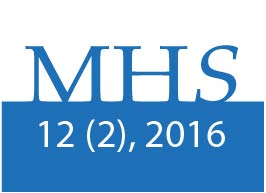Motor performance and physical activity habits of college students in Costa Rica
DOI:
https://doi.org/10.15359/mhs.12-2.2Keywords:
Physical activity, fundamental motor skills, young adults, sedentary behaviorAbstract
The purpose of this study was to analyze the motor performance of fundamental motor skills and physical activity habits of students at the University of Costa Rica. A total of 92 males and 48 females (M age = 19.78 yr., SD = 4.72 yr.) enrolled in different Sports Activity courses taught at the Rodrigo Facio campus was assessed. The Instrument for the Evaluation of Fundamental Movement Patterns was used to assess motor performance in eight fundamental movement patterns (running, jumping, galloping, catching, throwing, bouncing, and kicking). The physical activity level was obtained from a self-reported questionnaire developed for such purpose. Results show that 28% of the participants were physically active. Participants presented a proficient performance in kicking, running, and galloping, but a non-proficient performance in jumping, hopping, bouncing, throwing and catching. Physical activity behavior was related to the overall performance of the motor skills assessed (Rho = .233; p = .006). In conclusion, college students presented a proficient performance on three of the eight skills assessed. In addition, a relationship was found between physical activity levels and performance. Physical Education teachers are recommended to develop activities to enhance motor performance of fundamental motor skills in college students.References
American College of Sports Medicine [ACSM]. (2011). Quantity and Quality of Exercise for Developing and Maintaining Cardiorespiratory, Musculoskeletal, and Neuromotor Fitness in Apparently Healthy Adults: Guidance for Prescribing. Exercise Medicine & Science in Sports & Exercise, 43(7):1334-1359. http://dx.doi.org/10.1249/MSS.0b013e318213fefb
Clark, J.E. (2007). On the problem of motor skill development. Journal of Physical Education, Recreation and Dance, 78(5), 39-44. http://dx.doi.org/10.1080/07303084.2007.10598023
Cohen, K. E., Morgan, P. J., Plotnikoff, R. C., Callister, R. & Lubans, D. R. (2014). Fundamental movement skills and physical activity among children living in low-income communities: a cross-sectional study. International Journal of Behavioral Nutrition and Physical Activity, 11(1), 49-58. http://dx.doi.org/10.1186/1479-5868-11-49
Düger, T., Bumin, G., Uyanik, M., Aki, E. & Kayihan, H. (1999). The assesment of Bruininks-Oseretsky test of motor proficiency in children. Pediatric Rehabilitation, 3 (3), 125-131.
Gabbard, C. P. (2012). Lifelong Motor Development (6th ed.). San Francisco: Benjamin-Cummings Publishing Company.
Gallahue, D. L. & Ozmun, J. C. (2005). Understanding Motor Development: Infants, Children, Adolescents, Adults (6th ed.): McGraw-Hill Higher Education.
Hardy, L. L., Reinten-Reynolds, T., Espinel, P., Zask, A. & Okely, A. D. (2012). Prevalence and correlates of low fundamental movement skill competency in children. Pediatrics, 130(2), e390-e398. doi: 10.1542/peds.2012-0345
Jiménez, J., Salazar, W. y Morera, M. (2013). Diseño y validación de un instrumento para la evaluación de patrones básicos de movimiento. Motricidad. European Journal of Human Movement, 31(0), 87-97.
Logan, S. W., Robinson, L. E., Wilson, A. E. & Lucas, W. A. (2012). Getting the fundamentals of movement: A meta-analysis of the effectiveness of motor skill interventions in children. Child: Care, Health and Development, 38(3), 305-315. doi: 10.1111/j.1365-2214.2011.01307.
Ministerio de Salud. (2010). Estimación de muertes atribuibles a principales factores de riesgo en Costa Rica, 2005. Recuperado de: https://www.ministeriodesalud.go.cr/
Morgan, P. J., Barnett, L. M., Cliff, D. P., Okely, A. D., Scott, H. A., Cohen, K. E. & Lubans, D. R. (2013). Fundamental Movement Skill Interventions in Youth: A Systematic Review and Meta-analysis. Pediatrics, 132(5), e1361-e1383. http://dx.doi.org/10.1542/peds.2013-1167
Oficina de Bienestar y Salud, Universidad de Costa Rica [OBS]. (2011). Análisis de situación integral de salud de los estudiantes de primer ingreso 2011 de la Oficina de Bienestar y Salud. Comunicación personal con el Dr. Saúl Aguilar Morales (6 de junio, 2012).
Organización Mundial de la Salud [OMS]. (2010). La Organización Mundial de la Salud y el Comité Olímpico Internacional firman un acuerdo para fomentar los modos de vida sanos. Recuperado de: http://www.who.int/mediacentre/news/releases/2010/ioc_20100721/es/
Spessato, B., Gabbard, C., Robinson, L. & Valentini, N. (2012). Body mass index, perceived and actual physical competence: The relationship among young children. Child: Care, Health and Development, 39(6), 845-850. http://dx.doi.org 10.1111/cch.12014
Spessato, B., Gabbard, C. & Valentini, N. C. (2013). The role of motor competence and body mass index in children’s activity levels in physical education classes. Journal of Teaching in Physical Education, 32(2), 118-130.
Stodden, D. F. & Goodway, J. D. (2007). The dynamic association between motor skill development and physical activity. Journal of Physical Education, Recreation & Dance, 78(8), 33-49. http://dx.doi.org/10.1080/07303084.2007.10598077
Stodden, D. F., Goodway, J. D., Langendorfer, S. J., Roberton, M. A., Rudisill, M. E., Garcia, C. & Garcia, L. E. (2008). A developmental perspective on the role of motor skill competence in physical activity: An emergent relationship. Quest, 60(2), 290-306. doi: http://dx.doi.org 10.1080/00336297.2008.1 0483582
Stodden, D. F., True, L. K., Langendorfer, S. J. & Gao, Z. (2013). Associations among selected motor skills and health-related fitness: indirect evidence for Seefeldt’s proficiency barrier in young adults? Research Quarterly for Exercise and Sport, 84(3), 397-403. http://dx.doi.org/10.1080/02701367.2013.814910
Trejos, C. y Solís, M. (2011) Estilos de vida en Costa Rica: estudiantes universitarios de primer ingreso.
Wrotniak, B. H., Epstein, L. H., Dorn, J. M., Jones, K. E. & Kondilis, V. A. (2006). The relationship between motor proficiency and physical activity in children. Pediatrics, 118(6), e1758-e1765. http://dx.doi.org/10.1542/peds.2006-0742
Downloads
Published
How to Cite
Issue
Section
License
General conditions
MHSalud: Journal in Human Movement Sciences and Health by the Universidad Nacional is cover under a Creative Commons Atribución-NoComercial-SinDerivadas 3.0 Costa Rica license.
The journal is hosted in open access repositories such as the Institutional Repository of the Universidad Nacional, the Kimuk Repository of Costa Rica and La Referencia.
The editorial source of the journal must be recognized. Use the doi identifier for this purpose.
Self-archiving policy: The journal allows the self-archiving of the articles in their peer-reviewed version, edited and approved by the Editorial Board of the Journal to be available in Open Access through the Internet. More information in the following link: https://v2.sherpa.ac.uk/id/publication/25815



















